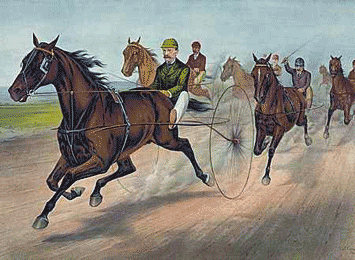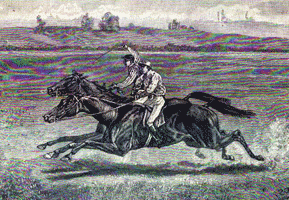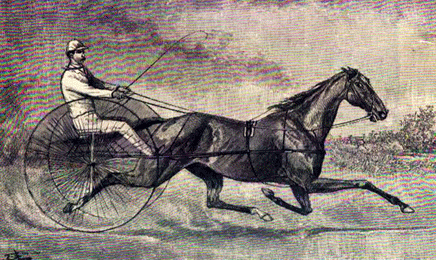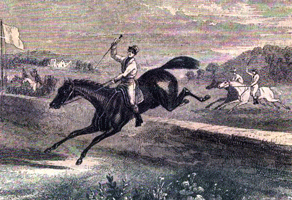|
|
Progress Publishing Co. |
|
|
Horse Racing Types |
|
|
Progress Publishing Co. |
|
|
Horse Racing Types |

![]()

![]()
Horse Racing Types
*******************************************************************
Three major types of horse racing
Horses’ breeds used in horse racing
Thoroughbred horse racing
Harness horse racing
Steeplechase horse racing
*******************************************************************
There are three major types of horse racing: thoroughbred racing, harness racing and steeplechase. The difference between them is in the breeds of horses used and the type of the surface of the race track. The race path is flat for thoroughbred and harness racing while the racecourse for steeplechase is uneven and filled with natural and man-made obstacles.

Thoroughbred horse racing
Thoroughbred Horse Racing
Thoroughbred horse races are held on a flat surface. In this type of racing the horse is saddled and ridden by a rider on round and oval tracks. The favorite breed is thoroughbred. Thoroughbreds were the result of crossbreeding between English and Arab horses. This breed of horses can be traced as far as early 1600s. It is a popular belief that all modern thoroughbred horses are descendants of 3 Arabian stallions. Thoroughbred horse is fast and can run a mile at 37-40 miles per hour. Thoroughbreds don’t posses a great stamina and because of that they don’t usually warm up before the races. The horse is rested on the day of the races all the way to the start of the competition. When thoroughbred horses run they gallop unlike harness horses which usually trot or pace. Due to the lack of stamina thoroughbred horse does not run more than one race per day. Thoroughbred racing is probably the most popular of all racing types.
The earliest thoroughbred horse race – The Chester Cup – took place in England in 1512. The most famous race – the Derby- was established in 1780 by the 12th Earl of Derby. Since then it’s been run annually in June at Epsom Downs racetrack 14 miles from London. In the United States the biggest annual thoroughbred race is the Kentucky Derby.

Harness racing with standardbred horse
Harness Horse Racing
This is the type of horse racing where the horses pull a light two-wheeled vehicle called “sulky”. The driver sits behind the horse with his feet on “stirrups” attached to the shaft. He uses harness to control the horse’s movement. Harness races use standardbreds, which originated from early thoroughbreds. Unlike thoroughbreds, a standardbred horse does not gallop during the race but runs at a fast trotting pace. The other difference between the two breeds is their appearance. Standardbred horse is not as tall as thoroughbred; it has a longer body and heavier legs and does not look as beautiful as thoroughbreds. Standardbred horse has more endurance than thoroughbreds. It warms up for the few miles before the race and can run few races a day. The trotting speed of the standardbred horse is slower than thoroughbreds' gallop – about 30 miles for a mile distance and up to 35 miles on the homestretch. The biggest harness racing track is the Roosevelt Raceway on Long Island, New York.

Steeplechase horse racing
Steeplechase Horse Race
A steeplechase racing course is a type of race, which is held on uneven surface filled with natural and artificial obstacles such as fences, ponds, bushes, walls etc… The horse ridden by the jockey has to jump over multiple obstacles without losing the riders. That type of racing took its name from the informal races of 17th century, when the riders used steeples of the local churches as the landmarks showing them the right course. Many believe that steeplechase racing evolved from the sport of hunting when the mounted hunters with their hound dogs were chasing hares, foxes, stags and bores. The most prestigious steeplechase horse race in the world was established in 1836 at Aintree not far from Liverpool.
Copyright Progress Publishing Co. 2006
Selected References:
| John Scarne New Complete Guide to Gambling | The Gambling Times Guide to Winning Systems |
| Kelso Sturgeon Guide to Sports Betting | Alice Fleming Something for Nothing/A History of Gambling |
| Carl Sifakis The Encyclopedia of Gambling | Alan Wykes The Complete Illustrated Guide to Gambling |